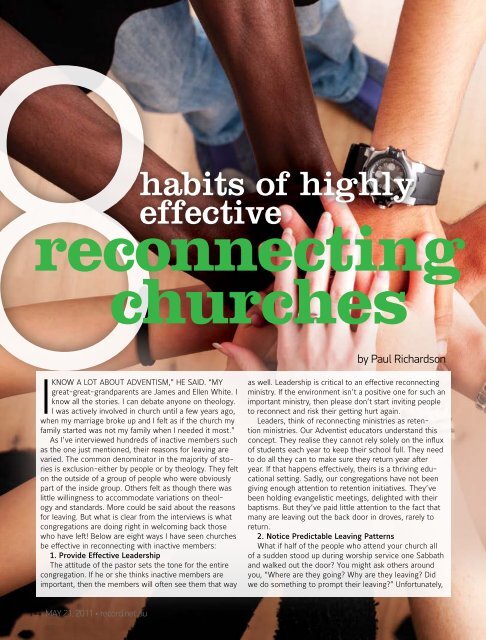Download RECORD as a PDF - RECORD.net.au
Download RECORD as a PDF - RECORD.net.au
Download RECORD as a PDF - RECORD.net.au
Create successful ePaper yourself
Turn your PDF publications into a flip-book with our unique Google optimized e-Paper software.
habits of highly<br />
effective<br />
reconnecting<br />
churches<br />
I<br />
know a lot about Adventism,” he said. “My<br />
great-great-grandparents are James and Ellen White. I<br />
know all the stories. I can debate anyone on theology.<br />
I w<strong>as</strong> actively involved in church until a few years ago,<br />
when my marriage broke up and I felt <strong>as</strong> if the church my<br />
family started w<strong>as</strong> not my family when I needed it most.”<br />
As I’ve interviewed hundreds of inactive members such<br />
<strong>as</strong> the one just mentioned, their re<strong>as</strong>ons for leaving are<br />
varied. The common denominator in the majority of stories<br />
is exclusion-either by people or by theology. They felt<br />
on the outside of a group of people who were obviously<br />
part of the inside group. Others felt <strong>as</strong> though there w<strong>as</strong><br />
little willingness to accommodate variations on theology<br />
and standards. More could be said about the re<strong>as</strong>ons<br />
for leaving. But what is clear from the interviews is what<br />
congregations are doing right in welcoming back those<br />
who have left! Below are eight ways I have seen churches<br />
be effective in reconnecting with inactive members:<br />
1. Provide Effective Leadership<br />
The attitude of the p<strong>as</strong>tor sets the tone for the entire<br />
congregation. If he or she thinks inactive members are<br />
important, then the members will often see them that way<br />
by P<strong>au</strong>l Richardson<br />
<strong>as</strong> well. Leadership is critical to an effective reconnecting<br />
ministry. If the environment isn’t a positive one for such an<br />
important ministry, then ple<strong>as</strong>e don’t start inviting people<br />
to reconnect and risk their getting hurt again.<br />
Leaders, think of reconnecting ministries <strong>as</strong> retention<br />
ministries. Our Adventist educators understand this<br />
concept. They realise they cannot rely solely on the influx<br />
of students each year to keep their school full. They need<br />
to do all they can to make sure they return year after<br />
year. If that happens effectively, theirs is a thriving educational<br />
setting. Sadly, our congregations have not been<br />
giving enough attention to retention initiatives. They’ve<br />
been holding evangelistic meetings, delighted with their<br />
baptisms. But they’ve paid little attention to the fact that<br />
many are leaving out the back door in droves, rarely to<br />
return.<br />
2. Notice Predictable Leaving Patterns <br />
What if half of the people who attend your church all<br />
of a sudden stood up during worship service one Sabbath<br />
and walked out the door? You might <strong>as</strong>k others around<br />
you, “Where are they going? Why are they leaving? Did<br />
we do something to prompt their leaving?” Unfortunately,<br />
14 MAY 21, 2011 • record.<strong>net</strong>.<strong>au</strong>

















